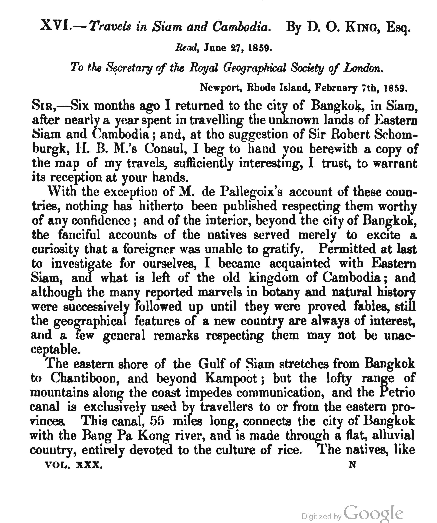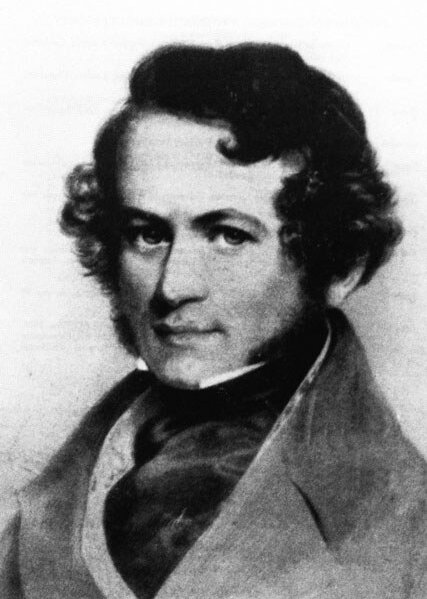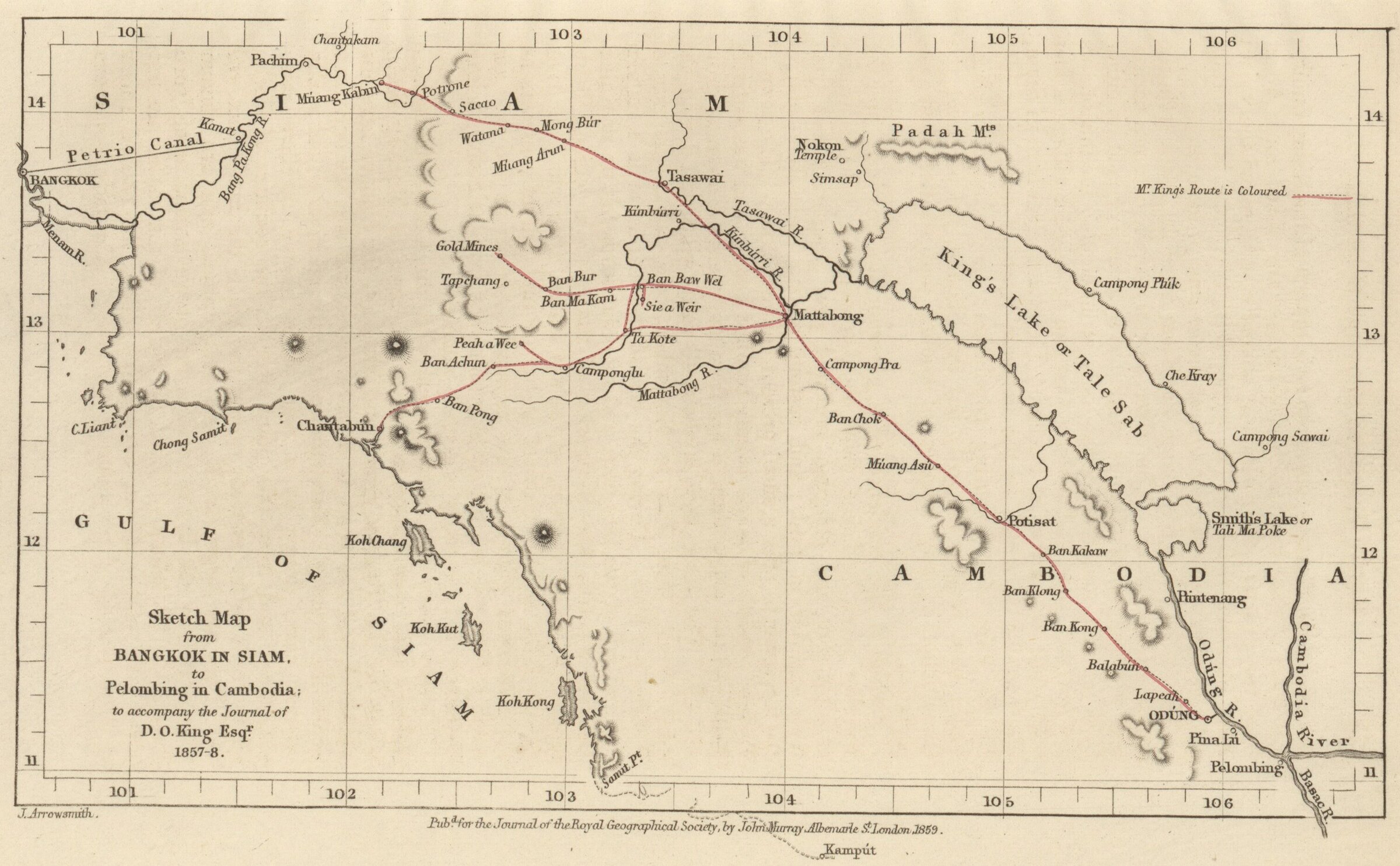Travels in Siam and Cambodia
by David Olyphant King
"The temple stands solitary and alone in the jungle, in too perfect order to be called a ruin, a relic of a race far ahead in all arts and sciences."
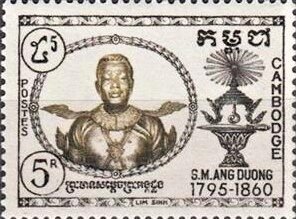
Publication: Journal of the Royal Society of Geography, Vo. XXX, Art. XVI, pp 177-182 | Read 27 June 1859
Published: 1859
Author: David Olyphant King
Pages: 5
Language : English
pdf 8.5 MB
This letter to the Secretary of the Royal Geographical Society of London, dated Newport, Rhode Island, February 7th, 1859, might be the first publshed account of Angkor (then called Nokon, under Siamese jurisdiction), and of King Ang Duong at Oudong, by an American traveler.
Bud did D.O. King actually went to Angkor? The map he added to the letter does show Nokon [Angkor], north of the King’s Lake or Tale Sab [Tonle Sap], yet his itinerary through Cambodian lands seems to have remained along the military road built by the Siamese from Mooang Kabin [Kabin Buri] to Mattabong [Battambang] and Odung [Udong], leaving it only to wander to gold mines north-west of Battambang and to reach the coast at Chantiboon [north of Koh Kong], probably to travel back to Bangkok by boat.
We have been able to find some indications about the author, until now left under the enigmatic identity of “D.O.King”. The image we get is of a young (he was 28 when he came to Siam and Cambodia) American traveler with reliable acquaintances in the small world of American and British missionaries, traders, geographers and diplomats then active in Siam.
Times of Opening to the West
- On 8 April 1855, the Bowring Treaty, opening “peaceful” and commercial relations between Siam and the UK, has been signed by the Siamese representatives and Sir John Bowring, the British envoy and governor of Hong Kong. Bowring, a Unitarist, had was open-minded towards the Catholics and befriended Mgr Pallegoix.
- On 30 May 1856, Presbyterian missionary Stephen Mattoon, who had been active as a Christian proselyt for several years, became the first American consul (representative) in Bangkok.
- In April 1856, the first British consul to Siam, Charles Batten Hillier — who was to die from illness in November at the age of 36 — and his young wife Eliza stayed with Mattoon and wife Mary while awaiting for a proper residence to be arranged for them in Bangkok.
- The next British consul, Sir Robert Hermann Schomburgk (1804 – 1865), a German-born explorer, geographer, ethnologist and botanist, had known the author’s family while he unsuccessfully attempted to grow tobocca plantations in Virginia. It was at his “suggestion” that D.O. King went to Cambodia, Schomburgk then focusing his attention to the Kingdom of Cheng Mai and Burma, which he visited during a 135 days journey. Later on, Schomburgk (or Schomburgh) assisted Henri Mouhot’s in his travels.
Sir Robert Schomburgk
- American traders such as David W.C. Olyphant (1789−1851), who were active in China since the 1820s, were looking for new avenues across the Far East. Olyphant was close to the author’s family, to the extent that the author was given his name as surnames, and that he was one of the trustees of the will left by the author’s mother, Harriet Vernon King, who had passed away in 1852.
The Travels
- When? From the letter, we learn that D.O. King returned to Bangkok in August or July 1858 “after nearly a year travelling the unknown lands of Eastern Siam and Cambodia”. Thus, the journey to Cambodia occurred in 1857 – 1858. We suppose the author went with young British diplomat Edward Forrest.
- If his description of the “Great Lake” is rather accurate, he names it “King’s Lake”, and “Smith’s Lake” for the lower part, toponymy that we did not encounter in other 19th century relations so far.
- Contrary to most of the contemporary authors, including Mgr Pallegoix, he aptly describes the “Nokon temple” (Angkor) as “built of a hard grey sandstone, without wood, cement, or iron in its composition, the blocks of stone fitting to each other with wonderful precision; and the whole temple, within and without, covered with carefully executed bas-reliefs of Buddhist idols (…) On the eastern verandah a square tablet of black marble has been let into the wall covered with writing, and doubtless setting forth the main facts in the raising of the temple. The characters used are precisely similar to the present Cambodian alphabet, but so much has the use of the letters changed, that the present race cannot decipher it.”
- Perceptively, and while contemporary and later accounts will insist that Angkor was completely abandoned by the Cambodians, he notes that “a few priests reside outside its walls, and the place is visited as a shrine by the Cambodians.”
- D.O. King was indeed received by King Ang Duong, even if the purpose of the audition remains unknown. Of the Court at Oudong, he writes: “A wooden palisade, 20 feet high and 600 yards square, encloses a straggling collection of thatched houses, the residences of the nobles, in the centre of which a low brick-wall encloses the palace, mint, and arsenal. Everything bespeaks poverty and the recent ravages of war, but nothing could exceed the friendliness of the welcome extended to us by the King, and we were assured that foreign travellers would be granted every facility.”
Photo: King Ang Duong on a Cambodian stamp.
Tags: 19th century, American travelers, Siam, King Ang Duong, Buddhism, decline and fall
About the Author
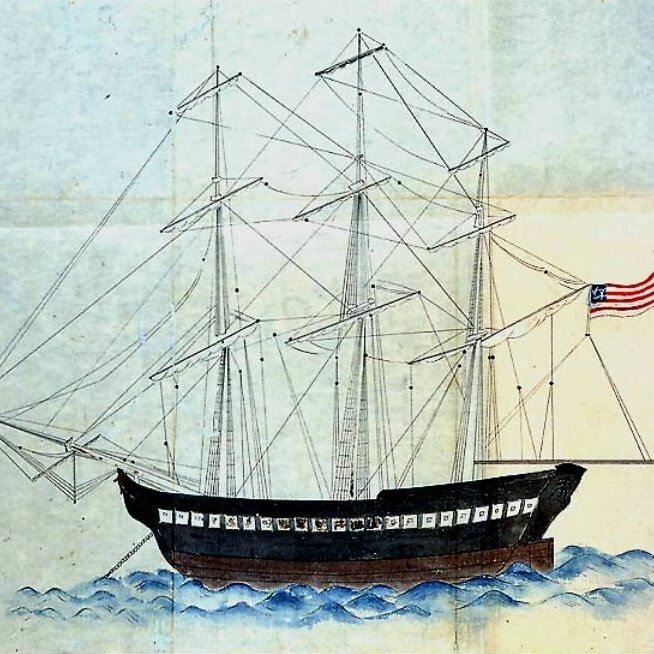
David Olyphant King
David Olyphant King (1828, Newport, Rhode Island, USA — 1862?, American Civil War in Virginia), D.0. King, was an American businessman and traveler who gave a published account of Angkor and the Cambodian royal court at Oudong in 1859.
D.O. King — he was given the name of a close associate to his father –, the merchant David Olyphant — was the seventh and last son of Samuel Vernon King (1772−1852) — a successful New York merchant who pioneered the Asian trade and co-founded the King Talbot & Co. trading company, which became Olyphant Talbot & Co. after bankrupcy — and Samuel’s cousin Harriet Vernon King (1783−1852). While their father traveled extensively to the East, residing “in opulence” in Macao at some point, three of his four eldest brothers (apart Samuel Vernon King II (1804−1887)) died abroad during their commercial endeavors : Charles William King (1) (1809−1845, died on a ship and was buried in the Red Sea while returning to America from Canton); James Rivers King (1819−1848, died in Amoy, China, while working with Olyphant Talbot); Frederick King (“lost in a Typhoon in the China Sea”, according to the records).
David Olyphant King arrived in Bangkok in 1856, possibly attracted by the fact that Rev. Charles Mattoon has been appointed as US consul in May 1856. He donated the funds for the land on which was built the Bangkok Presbyterian Mission School in November 1857, “on the west bank of the river in the lower suburbs known as Sumray”, according to Rev. Samuel Reynolds House, an American physician and missionary. His journey to Cambodia was instigated by his American and British acquaintances.
We do not know whether he intended to travel more around Asia, or his visit to Siam and Cambodia was merely circumstancial. He was back in America at the beginning of 1859. When the American Civil War broke out in April 1861, he joined the Union forces. In the official records, he is reported as “David King, from the Company H, 108th Reg., wounded in the Battle of Fredericksburg, 23 December 1862”.
(1) Charles W. King was high-ranked in the Olyphant company, since he headed the (disarmed) SS Morrison during the aborted attempt to land to Japan for commercial purposes in July 1837. Official trade between America and Japan would start 16 years, when, on July 8, 1853, American Commodore Matthew Perry led his four ships into the harbor at Tokyo Bay, after more than two centuries of Japanese isolation.
Photo: The American merchant ship Morrison, sailing for Olyphant & Co., vainly attempted to reach the Japanese shores in July 1837.

